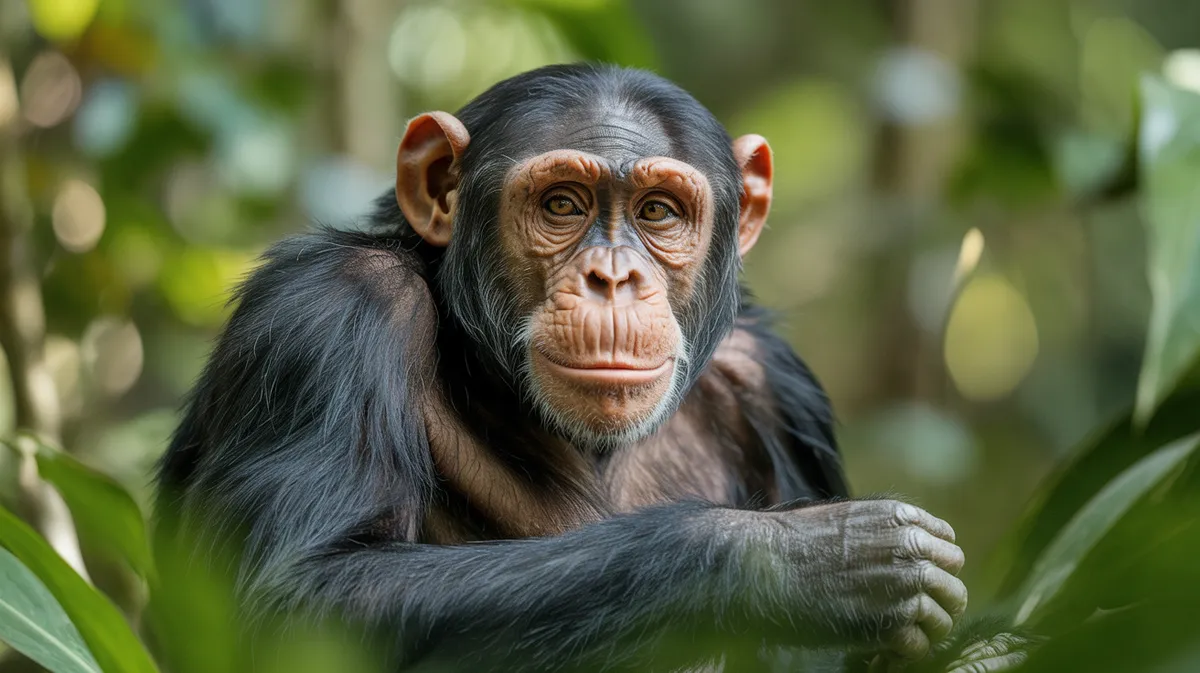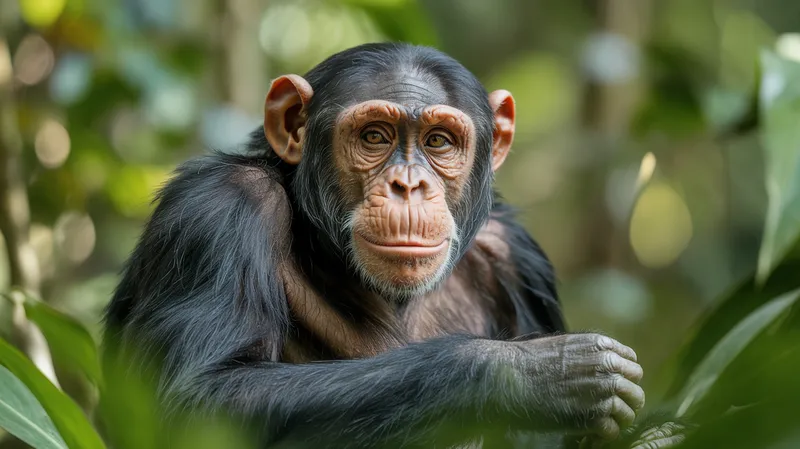
Great Apes Chimpanzee
Pan troglodytes

Meet the Great Apes Chimpanzee
The Great Apes Chimpanzee is an intelligent and social primate native to the forests and savannas of central and West Africa. Closely related to humans, chimpanzees live in complex communities and exhibit remarkable tool use, communication, and problem-solving abilities. They have a robust build, long arms, and expressive faces, and their social structures are characterized by strong bonds and frequent grooming. Chimpanzees play a vital role in their ecosystems as seed dispersers and are known for their adaptability to different habitats. Sadly, their populations are threatened by habitat loss, disease, and poaching.
Classification
Mammal
Habitat
Tropical rainforest and woodland savanna
Diet
Omnivore
Lifespan
33-40 years in the wild, up to 60 years in captivity
Conservation
Endangered
Weight
32–60 kg (70–130 lbs)
📖Fascinating Facts
Tool Users
Chimpanzees are one of the few animal species that regularly make and use tools, such as twigs for 'fishing' termites from mounds.
Rich Communication
They communicate using a wide range of vocalizations, facial expressions, and gestures, each with specific meanings within their social groups.
Arboreal & Terrestrial
Chimpanzees are both arboreal (tree-dwelling) and terrestrial, spending time foraging in trees as well as traveling and nesting on the ground.
📋Detailed Description
The chimpanzee (Pan troglodytes) is a large, robust-bodied primate with males averaging 40–60 kg and females 27–50 kg in weight, and standing up to 1.2 meters tall when upright. Their arms are notably longer than their legs, an adaptation for both arboreal and terrestrial locomotion, allowing for efficient knuckle-walking and climbing. Chimpanzees have coarse black hair covering most of their bodies, except for their faces, ears, palms, and soles, which are bare and expressive. Their facial features are highly mobile, enabling a wide range of social signals and emotional expressions. Chimpanzees live in fission-fusion societies, where community sizes can range from 20 to over 150 individuals, but subgroups (parties) change composition frequently. Social hierarchies are complex, with dominant males (alphas) leading but alliances and female relationships also playing crucial roles. Chimpanzees are renowned for their advanced cognitive abilities, including tool use, problem-solving, and cultural transmission of learned behaviors. Their diet is highly varied, consisting of fruits, leaves, seeds, insects, and occasionally meat, obtained through cooperative hunting. Reproduction is characterized by slow rates, with females giving birth to a single infant every 5–6 years after a gestation of about 230 days. Chimpanzees exhibit extended parental care, with infants dependent on their mothers for up to 5 years. Their ecological role as seed dispersers and predators influences forest dynamics and biodiversity.
💡 Did you know?
Chimpanzees and humans share about 98-99% of their DNA, making them our closest living relatives alongside bonobos.
🔬Research & Sources
🎭Behavior & Social Structure
Chimpanzees display a wide range of complex behaviors. They are diurnal, spending daylight hours foraging, traveling, resting, and engaging in social activities such as grooming, playing, and displaying. Feeding behavior is opportunistic and omnivorous; they consume over 300 plant species and supplement their diet with insects, honey, eggs, and occasionally hunt small to medium-sized mammals, such as colobus monkeys, using coordinated group strategies. Tool use is widespread: chimpanzees fashion sticks to extract termites, use leaves as sponges to collect water, and employ stones to crack nuts. Social interactions are mediated by grooming, which reinforces alliances and reduces tension. Vocalizations, facial expressions, and gestures form a sophisticated communication system. Aggression can occur, especially in male dominance contests or intergroup encounters, which may result in lethal violence. Daily routines involve traveling several kilometers in search of food, with nesting in trees each night for safety.
👶Reproduction & Life Cycle
Chimpanzees have a polygynandrous mating system, with both males and females mating with multiple partners. Females exhibit sexual swellings during estrus, signaling fertility and attracting males. The gestation period lasts about 230–240 days (approximately 7.5–8 months). Births are typically singletons, though twins are rare. Infants are born helpless and cling to their mothers' ventral side for the first months, later riding on their backs. Weaning occurs gradually between 4 and 5 years of age, but juveniles remain closely associated with their mothers for several more years. Females reach sexual maturity at 13–15 years, males slightly later. Interbirth intervals are long, averaging 5–6 years, contributing to slow population growth. Parental care is primarily maternal, but alloparenting (care by other group members) is occasionally observed.
🛡️Adaptations & Survival
Chimpanzees possess several adaptations for their semi-terrestrial, semi-arboreal lifestyle. Their long arms and strong hands facilitate brachiation and knuckle-walking, while opposable thumbs and big toes enable precise grasping and manipulation of objects. Their large brains (average 400 cm³) support advanced cognition, memory, and social learning. Behavioral flexibility allows them to exploit diverse habitats and food sources, including the use of tools. Their fission-fusion social structure reduces competition for resources and enhances group defense. Vocal and gestural communication systems are highly developed, supporting complex social interactions and coordination. Their omnivorous diet and ability to hunt cooperatively are unique among great apes, providing access to high-protein foods.
📚Research Sources
🎨Cultural Significance
Chimpanzees have long fascinated humans, appearing in African folklore as tricksters or wise beings, and serving as symbols of intelligence and kinship in many cultures. In the West, they have been featured in literature, art, and popular media, often anthropomorphized due to their human-like behaviors. Historically, chimpanzees were hunted for meat and kept as pets or performers, though such practices are now widely condemned. Their close genetic relationship to humans (sharing about 98.7% of DNA) has made them central to debates on animal rights, cognition, and the ethics of animal research. Some traditional societies attribute spiritual significance to chimpanzees, viewing them as forest guardians or intermediaries between humans and nature.
🔬Recent Research & Discoveries
Recent research has revealed remarkable cultural diversity among chimpanzee populations, with distinct tool-use traditions and social customs transmitted across generations. Studies have documented regional differences in hunting techniques, grooming styles, and even medicinal plant use. Genetic analyses have clarified the relationships among the four recognized subspecies: P. t. verus, P. t. troglodytes, P. t. schweinfurthii, and P. t. ellioti. Long-term field studies, notably at Gombe (Tanzania) and Taï (Côte d’Ivoire), continue to yield insights into social dynamics, cooperation, and the evolution of altruism and aggression. Recent concerns focus on zoonotic disease transmission between humans and chimpanzees, emphasizing the need for strict health protocols in research and ecotourism. Advances in non-invasive monitoring, such as camera traps and genetic sampling from feces, are improving population estimates and conservation planning.
🎥Wildlife Videos

Mother Chimpanzee Teaches Baby to Catch Termites | Natural World: Wild Mother and Babies | BBC Earth
Primate mothers don't just teach practical skills to their young – emotional intelligence and cultural traditions are passed down ...
BBC Earth

A Rare Look at the Secret Life of Orangutans | Short Film Showcase
In the vanishing lowland rainforests of Borneo, new research is underway to uncover and understand the unique cultural ...
National Geographic

Best Monkey Moments | BBC Earth
There are more than 260 species of monkey worldwide, here are some of the best moments from our primate friends. Subscribe: ...
BBC Earth

Enter the Kingdom of the Great Apes with National Geographic
Prepare to enter the kingdom of the incredible species of great apes. "Kingdom of the Planet of the Apes" is now playing only in ...
National Geographic

Most VIOLENT Chimpanzee Society Ever Discovered | Rise Of The Warrior Apes
Subscribe to Discovery Australia for more great clips: https://bit.ly/DiscoveryAustralia In the summer of 1993, a scientist went in ...
Discovery Australia

Bonobos Hunt Down Colobus Monkeys | Queens | National Geographic
Bonobos use their intelligence to hunt down and taunt Colobus monkeys. Check out the full episode of Queens, Season 1 ...
National Geographic
🌍Habitat Information
The Great Apes Chimpanzee typically inhabits Tropical rainforest and woodland savanna environments. Great Apes Chimpanzees have adapted to their environments with specialized features and behaviors.
Primary Habitat:
Tropical rainforest and woodland savanna
More detailed habitat information will be available soon.
🛡️Conservation Status
The Great Apes Chimpanzee is currently classified as Endangered. Conservation efforts are crucial for preserving this species for future generations.
Common Threats:
- 🏠Habitat loss and fragmentation
- 🌡️Climate change impacts
- 🎯Hunting and poaching
- 🏭Human-wildlife conflict
⚠️Threats & Conservation Challenges
Major threats to chimpanzees include habitat loss and fragmentation due to logging, agriculture, and infrastructure development. Poaching for bushmeat and the illegal pet trade significantly reduce populations, while infectious diseases such as Ebola and respiratory viruses have caused catastrophic local declines. Human-wildlife conflict, especially in areas of expanding human settlement, leads to further mortality. Population trends are declining across most of their range, with an estimated 170,000–300,000 individuals remaining in the wild, a reduction of over 65% in the past 30 years. Conservation challenges include enforcing anti-poaching laws, mitigating disease transmission, and preserving large, connected habitats. Climate change poses additional long-term risks by altering forest composition and food availability.
🔬Scientific Classification
Scientific Name
Pan troglodytes
Classification Hierarchy
🔍 About Taxonomic Classification
Taxonomic classification is a hierarchical system used by scientists to classify and organize living organisms based on shared characteristics and evolutionary relationships.
The system moves from broad categories (Kingdom) to increasingly specific ones, with each animal's scientific name typically consisting of its Genus and species.
📝Community Notes
Share your observations and insights about the Great Apes Chimpanzee with our community of wildlife enthusiasts.
Join Our Community
Sign in to share your observations and connect with fellow wildlife enthusiasts.
Sign In to ContributeNo community notes yet
Be the first to share your observations about the Great Apes Chimpanzee!
Explore Great Apes Chimpanzee
Select a tab above to learn more about this amazing animal.
📸Photo Gallery
No photos available for this animal yet.
🌟Discover More Wildlife
Continue your journey of discovery with more fascinating animals from our database
